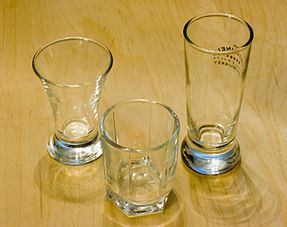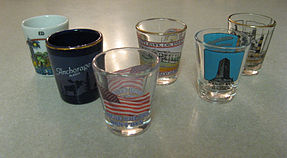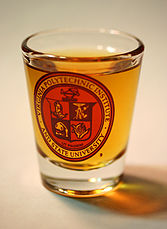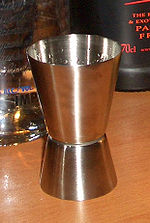- Shot glass
-
A shot glass is a small glass designed to hold or measure spirits or liquor, which is either drunk straight from the glass ("a shot") or poured into a mixed drink.
Shot glasses decorated with a wide variety of humorous pictures, toasts, and advertising, are popular souvenirs and collectibles.
Contents
Name origin
According to the Oxford English Dictionary, the term "shot glass" first appeared in print in the 1940s in The New York Times, but in fact several examples exist from the 1930s,[1][2] however although it was used by some,[3][4] the term apparently did not come into common usage until much later.
Many references from the 1800s describe giving a jigger of whiskey or rum to workers who were digging canals. Most shot glasses are found in the United States, but shot glasses from before the 1940s are very rare.[5]
Before Prohibition, thin-sided whiskey glasses were common. After Prohibition, these were replaced by shot glasses with a thick base and thick sides.[citation needed]
Because the word shot also means dose, or small amount it may simply be that these small glasses are called shot glasses because they hold small amounts. However there are a range of more complex stories about the origin of the style of glass, and its name. Few of them stands up to much scrutiny - either they place the origin decades before the term appeared in print, or they describe an item that had nothing to do with drinking liquor:
The Old West
The most popular[citation needed] origin story is that the shot glass originated in the Western saloons of the Old West. The story explains that the cowboys of the old west would trade a cartridge (bullet plus powder and primer encased in brass) for a small amount of alcohol.
Birdshot or buckshot
Another origin story is that a shot glass was a glass used at the dinner table for diners to place any lead shot they found left during the meal.
Quill pen holder
Another story ties the origin of the shot glass to the use of quill pens. According to this story, the term shot glass was coined over 100 years ago, describing a small, thick-walled glass placed on a writing desk, and filled with small lead shot. A feather writing quill would be placed in the glass when not in use, and the lead shot would hold the quill upright. An upright quill was more easily removed from the glass.
Firing glass
Certain fraternal organizations such as Freemasons have a custom of drinking toasts from specially shaped glasses known as cannons or firing glasses,[6] which are slammed on the table making a sound like a gunshot – a firing glass then becomes a shot glass. The firing glass is much older than the shot glass, and has a very specific shape with relatively thin sides, and a very thick protruding base.[7]
Friedrich Otto Schott
This theory argues that the word shot was originally spelled Schott, and named after Friedrich Otto Schott who co-founded the glassworks factory Jenaer Glaswerk Schott & Genossen in Jena, Germany in 1884.[8] This Jena glass has been theorized as the origin of the first Schott Glass and the source of the name, which was later, in the U.S., mutated to Shot Glass and the origin of the word forgotten.
Sizes
Most countries have standard definitions of single and double shot sizes (which are not always in a 2 to 1 ratio):
Country Small Single Double Notes Albania 50 mL 100 mL Australia 30 mL 60 mL Single shot is sometimes called a nip. At 30 mL, a typical spirit with 40% alcohol is roughly equivalent to one Australian standard drink.[9] Bulgaria 50 mL 100 mL Croatia 30 mL 60 mL Czech Republic 20 mL 40 or 50 mL 80 or 100 mL The most common single shot used to be 50 mL but recently it has become 40 mL. Denmark 20 mL 40 mL Estonia 40 mL 80 mL Finland 40 mL 80 mL In Finland, the maximum amount of strong alcohol restaurants are allowed to serve is regulated by law to one 40 mL portion at a time per customer. Doubles cannot be legally served. Germany 20 mL 40 mL In Germany, shot glasses (German: Schnapsglas, Pintchen, Stamperl) are smaller. Hungary 20 or 30 mL 40 or 50 mL 80 or 100 mL In Hungarian, shot glasses are called felespohár ("feles" meaning "half", standing for 0.5 dL), pálinkáspohár (for pálinka), kupica, or stampedli. India 30 mL 60 mL A 90 mL shot in India is called a Patiala Peg Ireland 35.5 mL 71 mL Israel 30 mL 50 or 60 mL In Israel, the common word for a small shot is "צ'ייסר" ("Chaser"). Italy 30 mL 40 or 60 mL In Italy, the common word for a shot is "cicchetto". In North Italy the "cicchetto" is the most common way to taste grappa from at least two centuries Kazakhstan 50 mL 100 mL In Russia, Kazakhstan, and other CIS (former Soviet) states there is also a larger бокал (glass or goblet), which usually contains 200–300 mL. New Zealand 15 mL 30 mL Poland 25 mL 50 mL 100 mL To take a single shot in Polish slang is to take po pięćdziesiątce, meaning take 50 (50 mL). Russia 50 mL 100 mL A double shot in Russian is called стопка meaning a stack; it also alludes to the number 100. Serbia 30 mL 50–60 mL A single shot is traditionally known in the Serbian language as чашица за ракију, meaning small glass for rakija, or simply as мера - мерица, meaning measure. A double shot is simply called Дупли, meaning a double. Sweden 20 mL 40 mL 60 mL Slovakia 20 or 25 mL 40 or 50 mL 80 or 100 mL The most common single shot size is the pol deci (literally, half a decilitre, 50 mL). Slovenia 30 mL 60 mL South Africa 25 mL The South African government has an official definition for the single shot size. South Korea 60 mL Turkey 1 finger 2 fingers 4 fingers United Kingdom 25 or 35 mL 50 or 70 mL Shots sold on-premises must contain either 25 mL or 35 mL measures of whisky, gin, rum, or vodka, as defined in the Weights and Measures Act of 1985. This requirement does not extend to other spirits. A 2001 amendment allowed a double shot of 70 mL to be served. Generally, a single measure is equal to 35ml in Northern Ireland and 25ml in the rest of Britain.[10] United States and Canada 1.0 US fl oz (30 mL) 1.5 US fl oz (44 mL) 3.0 US fl oz (89 mL) There is no standard size for a single shot, except in Utah, where a shot is defined at 1.5 fl oz.[11] Elsewhere in the U.S., the standard size is generally considered to be 1.25–1.5 fl oz.[12][13] In Canada, a "shot" generally refers to the province's definition of a "Standard Drink" under liquor licences. Although sizes may vary, most provinces cite amounts similar to Ontario's guidelines of 0.6 ounces or 17 mL of pure alcohol; since a "shot" is typically a spirit with 40% alcohol, this makes the shot 1.5 oz or 43 mL (though many establishments serve a lower "standard drink" of only 1 oz)[14]. A double shot in North America may be either 2.5 or 3.0 fl oz.[15] A smaller 1.0 fl oz shot is usually referred to as a pony shot or short shot.[16] Shot measuring tools
Jigger
A jigger or measure is a bartending tool used to measure liquor, which is typically then poured into a cocktail shaker. It is named for the unit of liquid it typically measures, 1.5 fluid ounce (~44 ml) jigger or shot.[17] However bar jiggers come in other sizes and may not actually measure a fluid jigger.
A traditional style of jigger is made of stainless steel with two unequal sized opposing cones in an hourglass shape on the end of a rod. Typically, one cone measures a regulation single shot, and the other some fraction or multiple - with the actual sizes depending on local laws and customs.
References
- Notes
- ^ "...whiskey and sour, which was served in a 2-ounce "shot" glass...", 1930, American law reports annotated , Volume 66
- ^ "He held his shot glass upside down and watched the last few drops of whisky roll down the side of the glass", 1939, Prairie schooner , Volumes 13-14, University of Nebraska Press
- ^ "...and brought out a bottle of brandy and a shot glass...", The Portsmouth Times - Sep 6, 1941
- ^ "...characters nursing a shot glass late at night in men's bars...", St. Petersburg Times - Aug 1, 1955
- ^ "The pre-Prohibition Collector's Resource Site". Pre-pro.com. http://www.pre-pro.com. Retrieved 2010-10-16.
- ^ "'Firing' Glass". Museum of Croydon. http://www.museumofcroydon.com/ixbin/indexplus?record=CAT3140&_IXEMBED_KIOSK_=kiosk/a2_k4&_IXFROMC_=1. Retrieved 2010-10-16.
- ^ "FIRING GLASSES, engraved firing glass, engraved glass crystal, crystal and engraving from WARWICK CRYSTAL DESIGNS, glass, gift, 3d. Order engraved crystal online". Warwickcrystal.co.uk. http://www.warwickcrystal.co.uk/shop/glasses/glass77.htm. Retrieved 2010-10-16.
- ^ "Jena glass". Encyclopædia Britannica. http://www.britannica.com/eb/article-9043517/Jena-glass. Retrieved 2008-05-19.
- ^ "Standard drinks guide". Department of Health and Ageing (Australian). http://www.health.gov.au/internet/alcohol/publishing.nsf/Content/drinksguide-cnt. Retrieved 10 April 2011.
- ^ 1 Unit
- ^ "Shotglass Size". Shotglass.org: a site for shotglasses and other similar items. http://www.shotglass.org/. Retrieved 2008-05-19.
- ^ Graham, Colleen. "Shot glass". About.com Cocktails: The Glassware Tour. About.com. http://cocktails.about.com/od/embellishments/ss/glss_gde_10.htm. Retrieved 2008-05-19.
- ^ Rowlett, Russ. "Units: S". How Many? A Dictionary of Units of Measurement. University of North Carolina at Chapel Hill. http://www.unc.edu/~rowlett/units/dictS.html. Retrieved 2008-05-19.
- ^ Smart Serve Ontario: Hospitality Industry Training Organization of Ontario. Smart Serve Ontario: Responsible Alcohol Beverage Service Training. Queen's Printer for Ontario,2002, p. 6.
- ^ Rowlett, Russ. "Units: D". How Many? A Dictionary of Units of Measurement. University of North Carolina at Chapel Hill. http://www.unc.edu/~rowlett/units/dictD.html. Retrieved 2008-05-19.
- ^ "Shot glass". Glass info. The Webtender. http://www.webtender.com/db/glass/2. Retrieved 2008-05-19.
- ^ Feller, Robyn M. (2003). The Complete Bartender. Berkley. ISBN 9780425190135.
External links
Beer glassware Beer glassware 
Stemware Stemware 
Other glassware Other glassware  Categories:
Categories:
Wikimedia Foundation. 2010.




